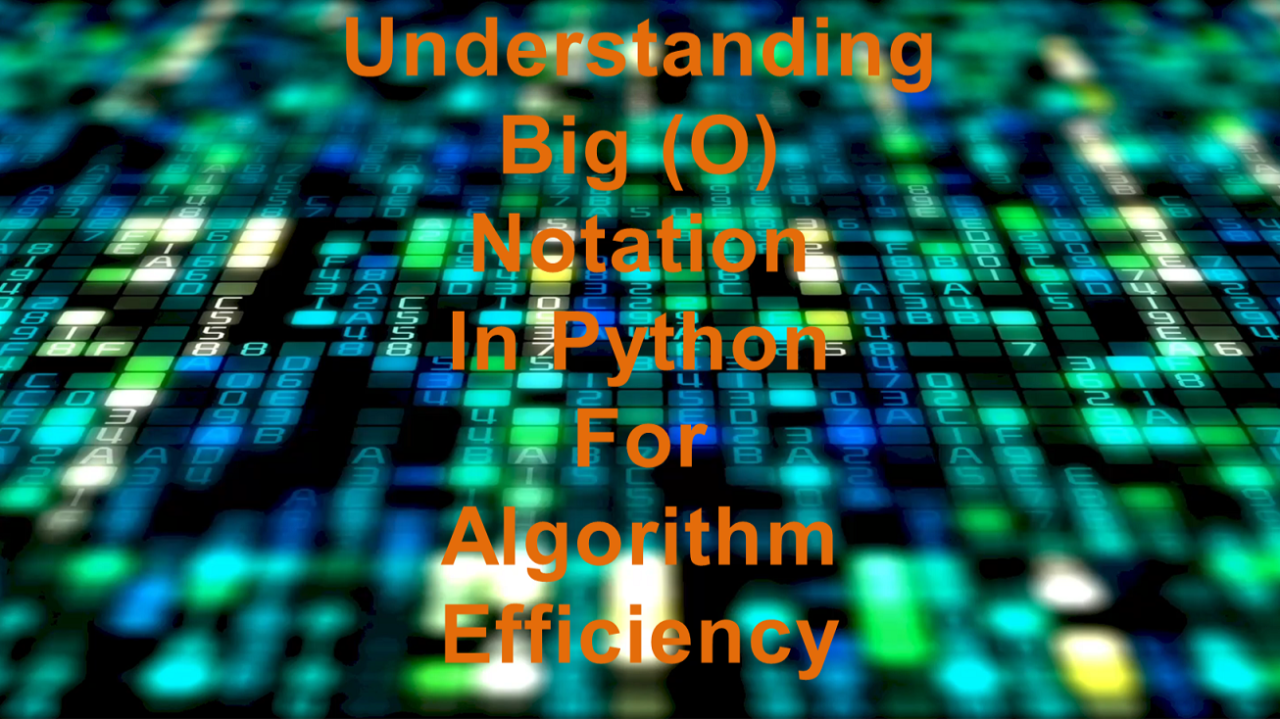
Understanding Big O Notation in Python For Algorithm Efficiency
Yamil Garcia
I'm an Electrical Software Engineer with a passion for combining my knowledge in the intricacies of electrical systems with the power of programming.
Table Of Content
1. Introduction
In the world of programming, efficiency is key. As data sets grow larger and applications become more complex, understanding how algorithms perform under varying conditions becomes crucial. Big (O) notation is a powerful tool that helps developers and computer scientists describe the performance and complexity of algorithms in a concise and meaningful way. This article aims to demystify Big (O) notation, explaining its significance and illustrating its application through practical examples in Python. Whether you're a seasoned developer or just starting out, grasping Big (O) notation will enhance your ability to write efficient, scalable code.
2. Purpose of Big (O) Notation
Big O notation focuses on the worst-case scenario, allowing us to express how the runtime or space requirements grow relative to the input size. This helps in:
3. Common Big (O) Notations
4. O(1) – Constant Time Example
An algorithm with O(1) complexity executes in constant time regardless of input size. For example, accessing an element in a list by its index is O(1) because it takes the same amount of time regardless of the list's length.
This code generates a list of 500 random numbers and measures the time it takes to access the first and 500th elements. The measured times are then printed to demonstrate that accessing any element in the list takes constant time, O(1).
5. O(n) – Linear Time Example
An algorithm with O(n) complexity has its execution time directly proportional to the input size. For instance, summing all elements in a list takes linear time because the time required grows with the number of elements, making it dependent on the list's length.
This code generates two lists, one with 5 random numbers and another with 500 random numbers, and measures the time it takes to sum all elements in each list. The measured times are then printed to demonstrate the difference in time for lists of different sizes, illustrating the linear time complexity, O(n).
6. O(n^2) – Quadratic Time Example
An algorithm with O(n^2) complexity has its execution time proportional to the square of the input size. For example, a nested loop where each element is compared with every other element exhibits quadratic time, meaning the time required grows significantly with larger inputs.
This code generates two lists, one with 10 random numbers and another with 100 random numbers, and measures the time it takes to perform a nested loop operation on each list. The measured times are then printed to demonstrate the difference in time for lists of different sizes, illustrating the quadratic time complexity, O(n^2).
7. O(log n) – Logarithmic Time Example
An algorithm with O(log n) complexity reduces the problem size by half with each step, resulting in very efficient performance. For example, binary search demonstrates this by repeatedly dividing a sorted list in half, quickly narrowing down the search space regardless of the list's length.
领英推荐
This code generates two sorted lists, one with 10000 random numbers and another with 10,000,000 random numbers, and measures the time it takes to perform a binary search on each list. The measured times are then printed to demonstrate the difference in time for lists of different sizes, illustrating the logarithmic time complexity, O(log n).
8. O(n log n) – Linearithmic Time Example
An algorithm with O(n log n) complexity, like merge sort, combines linear and logarithmic growth. It processes each element (O(n)) and divides the problem size with each step (O(log n)), resulting in efficient performance even for large datasets.
This code generates two lists, one with 1,000 random numbers and another with 100,000 random numbers, and measures the time it takes to perform a merge sort on each list. The measured times are then printed to demonstrate the difference in time for lists of different sizes, illustrating the linearithmic time complexity, O(n log n).
9. O(2^n): Exponential Time Example
An algorithm with O(2^n) complexity has its execution time doubling with each additional input element. This rapid growth makes such algorithms impractical for large inputs. For example, the naive recursive Fibonacci sequence calculation exhibits exponential time, leading to significant increases in computation time as n increases.
This code uses a naive recursive approach to calculate Fibonacci numbers, which has exponential time complexity, O(2^n). It measures the time taken to compute the 20th and 30th Fibonacci numbers and prints the results, demonstrating the significant increase in time required for slightly larger inputs due to the exponential growth in computation time.
10. Additional Resources
2. Big O(micron) Visualizer: A visual tool to help you understand how different algorithms scale with increasing input sizes.
3. Introduction to Algorithms, 3rd Edition by Thomas H. Cormen, Charles E. Leiserson, Ronald L. Rivest, and Clifford Stein: A classic textbook that provides in-depth coverage of algorithm design and analysis.
4. Algorithm Design Manual by Steven S. Skiena: Another excellent book that covers both the theory and practical aspects of algorithm design.
11. Conclusion
Big (O) notation serves as a fundamental concept in computer science, offering a lens through which we can evaluate and compare the efficiency of different algorithms. By understanding the various complexities, from constant time O(1) to exponential time O(2^n), developers can make informed decisions when designing and optimizing their code. Through practical examples in Python, we have explored how Big (O) notation applies to real-world scenarios, providing a clearer understanding of its importance. As you continue to develop your skills, keep Big (O) notation in mind—it will undoubtedly play a vital role in your journey towards writing efficient and effective software.
To access other exciting articles, projects, and resources, be sure to visit my GitHub page: